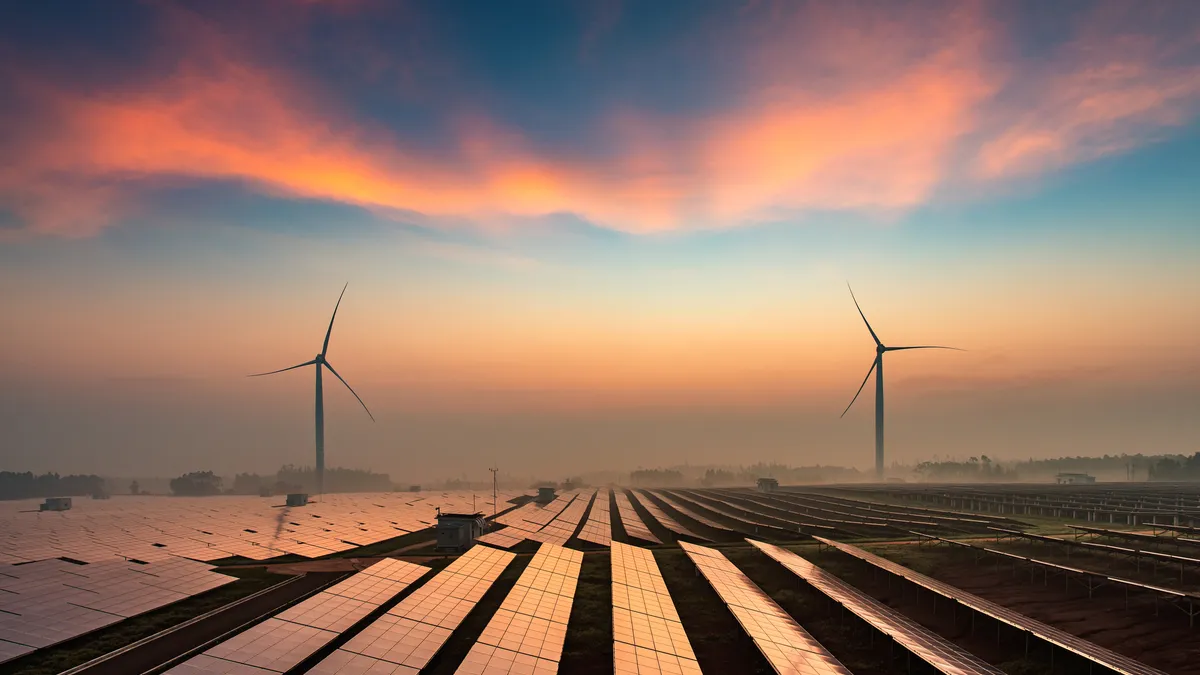Dive Brief:
- The cost for utility-scale solar PV power has declined 82% since 2010 and the costs for onshore and offshore wind have declined 39% and 29%, respectively, according to a report released Tuesday by the International Renewable Energy Agency.
- Price trends that have been falling for more than a decade will continue their decline with improved technology and expanded market participation, Marlene Motyka, Deloitte's Global and U.S. Renewable Energy Leader, told Utility Dive in an email. Motyka noted record-low prices for wind and solar in recent auctions.
- Leaders of U.S. hydro, solar, wind and storage industry associations unveiled their "Majority Renewables by 2030" plan in a June 2 industry roundtable. The four industry groups now have a shared vision for decarbonization of the power sector.
Dive Insight:
As renewable energy sources become cheaper than any new electricity capacity based on fossil fuels, four industry association leaders plan to expand market share over the next 10 years.
"We're talking about a radical market transformation," Abigail Ross Hopper, President & CEO of the Solar Energy Industries Association (SEIA) said during a June 2 virtual panel discussion.
However, the renewable power industries can expect to encounter political and regulatory resistance, Hopper said, as they begin "taking other people's market share."
But consumer demand may move recalcitrant politicians and regulators, according to Robert Dillon of the Energy Choice Coalition.
"We see increasing demand for renewables among consumers and that is both driving innovation among providers and support among policymakers," Dillon told Utility Dive in an email.
"The co-benefits of more affordable and cleaner energy sources is a win-win and the fact that it's a market-driven solution allows it to win over those who might have opposed renewable energy projects in the past," Dillon said.
Hopper and other renewable energy industry leaders intend to reduce the share of energy generated by nonrenewable sources to 49% by 2030.
Hopper joined Tom Kiernan, CEO of the American Wind Energy Association, Kelly Speakes-Backman, CEO of the Energy Storage Association, and Malcom Woolf, President & CEO of the National Hydropower Association, in a roundtable discussion to kick off the virtual events of Cleanpower 2020.
In the shared industry vision, solar energy would account for 20% of power generation by 2030, wind would provide another 20%, hydroelectric would account for another 9%, and the remaining 2% would come from other renewable energy resources. Energy storage — battery, hydro, mechanical and thermal — would provide the flexibility and reliability needed for renewables to become major players in the power sector, according to Speakes-Backman.
"2019 was a great year for wind," Kiernan said in his introductory remarks. "We're relentlessly innovating with longer blades and higher towers."
Findings in the IRENA report backed up the industry claims.
"Electricity costs from renewables have fallen sharply over the past decade, driven by improving technologies, economies of scale, increasingly competitive supply chains and growing developer experience," according to the report.
"Pricing trends are headed lower for the same reasons they've been falling for more than a decade — increasing scale, improved renewable energy technologies that boost capacity factors, and the expansion of market participation, especially in auctions that have continued to result in record-low prices for wind and solar," Deloitte's Motyka told Utility Dive.
"Data in the IRENA Auction and PPA Database indicate that solar PV projects that have won recent auction and power purchase agreements (PPAs) processes — and that will be commissioned in 2021 — could have an average price of just $0.039 per kilowatt-hour," the IRENA report said.
The renewable energy sector also could lead future economic stimulus plans, according to stakeholders.
Kiernan expects to see 83,000 new offshore wind jobs by 2030. Hopper predicted there will be 600,000 workers in the solar energy industry in 2030. Speakes-Backman and Woolf predicted there will be 200,000 jobs each in the storage and hydro industries.
The IRENA report agreed that renewable industries are cost-effective and easily scalable, boosting sagging economies
"Solar PV and onshore wind offer easy, rapid roll-out possibilities, while offshore wind, hydropower, bioenergy and geothermal technologies provide complementary and cost-effective medium-term investment options," according to the report.
Deloitte's Motyka agreed.
"Some governments are including renewable investment in their economic recovery plans, which will likely increase deployment and add further scale, helping bring prices down further."













